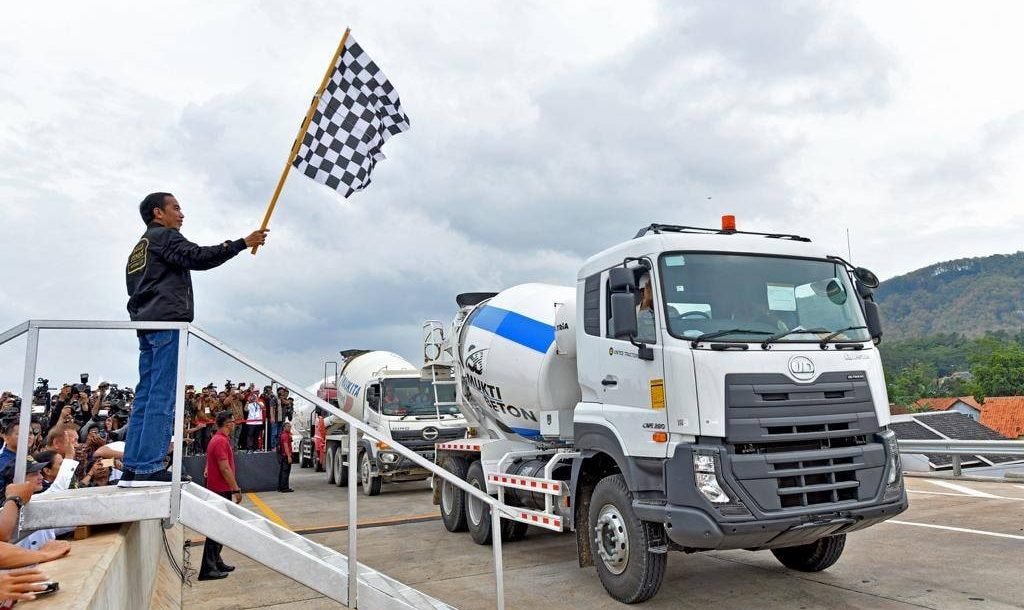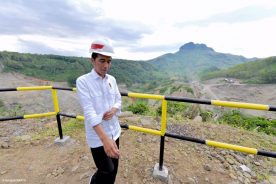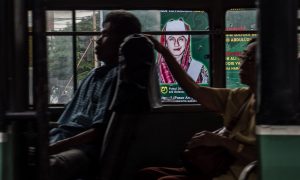In 2016, Eve Warburton correctly sized up the state of Indonesian President Joko “Jokowi” Widodo’s economic agenda: to focus narrowly on building up the country’s infrastructure as quickly as possible. Politically treacherous sectoral reforms, human rights issues and market liberalisation would take a back seat to the more expedient tactic of tasking state-owned companies with building airports, power plants and toll roads so he could champion big projects in the run-up to the 2019 election.
The promises made were ambitious, with big numbers splashed in the newspapers: 35,000MW of increased generating capacity, 1,000km of toll roads and 15 new airports by 2019. Now, after five years of working toward these goals a critical question is how much progress has been made.
There have been rumblings of dissatisfaction with the direction of the Indonesian economy during the last few years, namely that growth has been stuck around 5% per year—which is steady but not spectacular—and that investment has not materialised at the rate envisioned. Jokowi has also been criticised for widening inequality and an emphasis on ramming through big projects in the face of local resistance. Yet despite these challenges and setbacks, infrastructure is one sector, along with e-commerce and tourism, where big gains are being made.
So how sound is Jokowi’s infrastructure strategy? As Aichiro Suryo Prabowo recently argued at New Mandala, overreliance on state-owned companies risks crowding out the private sector, contributing to the entrenchment of bloated and inefficient state monopolies in vital sectors. Indonesia will need to court more private investment (both domestic and foreign) if it wants to realise its ambitious growth targets, but it may be handicapping itself in this regard if it continues giving away all the choicest contracts to state-owned and politically connected companies in the name of expediency.
This is a common criticism, and almost any analysis of Indonesia’s economy will include the well-worn caveat that market liberalisation and structural reforms targeting state-owned companies are needed.
However, the precise pathway by which these reforms will be accomplished is often left vague. This is because there is no easy way to wean Indonesia off its reliance on state-owned companies, both for historical reasons which have deeply embedded the state in economic development, and for practical reasons, namely that given Indonesia’s vast geographical and social heterogeneity, its burdensome regulatory environment, its wariness of foreign capital and its impossibly complex and redundant legal architecture, state-owned companies are the entities most realistically capable of executing big public works projects on the scale the country needs at the moment.
Development and the state
When talking about economic growth and development in Indonesia it is critical to be honest about the investment and regulatory climate as it actually exists, not as we would wish it to be in a neoclassical economic model.
The practical logic behind Jokowi’s preference for state-owned companies to lead the charge on infrastructure is based on an acknowledgement that the regulatory and legal environment in Indonesia makes it difficult to allocate private capital efficiently. Investors want certainty and efficiency, they want to know contracts will be honoured, and they want to know that regulatory schemes won’t change from year to year.
Unfortunately, these are not promises easily kept in Indonesia’s current regulatory environment, marked by often-incoherent laws and regulations, and persistent corruption. There really is no easy or quick way to fix this problem. Improving the quality of the civil service, for instance, will take more than a few policy reform packages—it takes generational change.
Instead, the more expedient way to overcome these myriad obstacles in the short-term is to concentrate power and authority at the central government level and simply push through them using the power of the state. This has, in turn, resulted in some people likening his state-led development efforts to those of Suharto. However, there are important differences in Jokowi’s approach that make it both more sustainable and arguably more equitable. Another very important point is that, broadly speaking, it is working.
All power to him
Take the example of the often-mocked “35,000MW” power program. As of December 2018 only 2,899MW (8% or so) of this total was actually operational. But these numbers are somewhat misleading and owe more to the fact that the government grossly over-promised, a characteristic of Indonesian policy-making that helps explain why the government always seems to be under-performing. If they set more realistic goals, their track record would surely be better.
Using more realistic expectations, the 35,000MW program seems less like fantasy. There are currently 7 megaprojects of 1,000MW or greater that have reached financial close and are already under construction. These projects, worth a total of US$17 billion, will reach completion in staggered stages over the next 1-4 years and add 11,000 MW of total generating capacity in Sumatra and Java. Most of these megaprojects are Public-Private Partnerships, where state-owned electricity utility PLN enters into long-term agreements to buy power from private developers at fixed rates. PLN was only able to get most of these projects to financial close by invoking the authority of the state to reassure skittish investors that they would be fast-tracked to overcome various hurdles.
When they initially tried to get the projects underway in 2015 and 2016, the Jokowi administration ran into predictable obstacles that have historically waylaid power projects: overlapping authority between local and central governments, confusing and often redundant regulations, and investor concerns about financing and land acquisition.
These were largely overcome through executive fiat. Big infrastructure projects, at the discretion of the government, can be designated via Presidential Regulations (Perpres) as Nationally Strategic, which allows them to bypass standard legal procedures and access state-backed financial guarantees. As a result of these steps, this slate of megaprojects (some of which had been dragging on for years) quickly reached financial close and will soon be selling electricity to PLN.
Roads to somewhere
Another signature Jokowi promise was to build 1,000km of new toll roads by 2019. At the time, this was viewed with scepticism, as Indonesia’s total toll road network amounted to maybe 800km, and past efforts had been hampered by disputes over land acquisition, rent-seeking and unclear lines of authority between central and local governments.
According to toll road regulator BPJT, during 10 years of SBY’s administration approximately 250km of toll roads went into operation. In 5 years under Jokowi, over 600km have become operational, with large sections slated for completion during 2019. The 1,000km mark might not be achieved by the end of 2019, but it will be close.
State-owned companies like Jasa Marga have been awarded the majority of the toll road concessions, worth billions of dollars. In order to finance the vast scale of construction, Jasa Marga has been issuing hundreds of millions of dollars in domestic and international bonds denominated in rupiah. It has also been accessing loan facilities from domestic banks which are similarly denominated in rupiah. This is a shrewd debt strategy, as it insulates the company from currency devaluation and satisfies economic nationalists who are loath to run up big foreign debts. It also means the government doesn’t have to borrow directly; Jasa Marga takes on the debt, which it can service through healthy revenue generated from its toll road operations.
The land question
The acceleration of toll road construction also demonstrates the important role of a landmark piece of legislation—Law No 2 of 2012 on Land Acquisition, which Jokowi inherited from the previous administration. The law recentralised authority for land use issues related to infrastructure at the central state level, reducing opportunities for local officials to gum up the works for their own personal reasons.
The law also created a statutory framework for the compulsory acquisition of land, which included an independent appraisal team responsible for determining compensation. It imposes strict deadlines on the process, and stipulates procedures for how impacted landowners can challenge the state in court. Prior to the enactment of this law, there was no deadline on this process—a major reason why land-intensive projects crossing multiple districts, such as toll roads, often languished for years. With the legal authority handed to him by the 2012 law, however, the pace of toll road construction has greatly accelerated under Jokowi.
The law has had great utility beyond the toll roads sector, being central to the progress of the New Yogyakarta International Airport (NYIA) project. The Governor of Yogyakarta (who is also the Sultan) granted state-owned airport operator Angkasa Pura I a Location Permit to acquire 587 hectares of rural farm land in the Kulon Progo Regency in March 2015. Within 3 years, all the land for the site had been released, and the airport, which has a project value of around US$800 million, is now over 50% complete and expected to be operational in 2020.
Compared to comparable airport projects in Indonesia, this is quite fast. The NYIA project is also notable because although there have been allegations of intimidation and dozens of people were ultimately forcibly removed from the site, the existence of a statutory framework governing the process is a tangible improvement over the previous state of affairs. Law No 2 of 2012 ensured, for instance, that the compensation the state paid reflected reasonable market value and that procedural safeguards allowed locals to sue the state in the district court, where they won (although the decision was ultimately overturned by the Supreme Court).
The compensation offered by Angkasa Pura to buy the land in Kulon Progo was reasonably fair, averaging around Rp700,000 per square metre. At the end of 2018, land could still be had near the airport for Rp1 million per square metre (or sometimes less) despite several years of inflationary pressure from speculative land buying. This suggests the price offered in 2015 was a fair one. A few hold-outs notwithstanding, the vast majority of the thousands of landowners who initially opposed the project eventually accepted the compensation after the process had worked its way through (including the farmers who had sued to stop the project). Only a few dozen refused to vacate the site under any terms.
The NYIA case calls into question the portrayal of Jokowi’s statist development model as New Order-style authoritarianism dressed up in new clothes. While it is true that farmers were displaced from their land so that the state could pursue its developmental agenda, they were compensated fairly and had clear legal avenues available to contest those actions. The Supreme Court has not been very sympathetic to the claims of farmers in these land disputes, but many judges at the district court level have been. The fact that a process exists at all where landowners can contest the will of the state, and that lower courts are often receptive to these arguments, is a far cry from how the New Order seized land from Sasak farmers to build the Lombok airport in the 1990s, using coercive threats and violence to force landowners to accept rock-bottom prices.
How does New Developmentalism stack up?
Infrastructure development under Jokowi has followed a familiar path: state-owned companies are building most of the airports and toll roads, while PLN pays private developers to build large power plants. The state has sought to claw back power from local and regional authorities and recentralize it in Jakarta, equipping itself with increased authority to overcome administrative roadblocks, issue financial guarantees and invoke Law 2 of 2012 to streamline the acquisition of land.
The result has been a rapid acceleration in infrastructure projects. Not all of the ambitious targets will be realised, but more progress is being made than many expected. Moreover, many of the state-owned companies doing the work are financing their efforts through bonds and loans payable in Rupiah, reducing exposure to large and potentially ruinous foreign debts and external shocks like currency devaluation. By having state-owned companies function as off-balance sheet proxies, this also helps the government of Indonesia keep its fiscal house in order. This strategy could back-fire if the state-owned companies become insolvent, but at the moment companies like Jasa Marga and Angkasa Pura have very healthy balance sheets.
Some will doubtless find this progress wanting, emphasising the bureaucratic inefficiencies and protectionist tendencies that persist under Jokowi, and painting state-led development as an unsustainable concession to economic nationalism. Moreover, despite the scale of investment in infrastructure, the economy has not grown at the rate predicted, leaving some to wonder what the point of it all is.
Building a better infrastructure policy after Indonesia’s elections
Jokowi’s overreliance on state-owned enterprises has undesirable side-effects. But the private sector has its own problems.
There is no doubt this approach has shortcomings. More private investment is surely needed, especially in manufacturing and service industries. Despite its critical role in speeding up infrastructure projects, Law No 2 of 2012 also has shortcomings, mainly that it only acknowledges legally registered land titles which, to put it mildly, don’t always exist in Indonesia. More pro-poor policies are also needed (toll roads, for instance, mainly benefit people who are already wealthy enough to afford a car and pay the toll).
The massive amounts of money being poured into state companies to build infrastructure has certainly created opportunities for fraud and corruption and waste, and it has helped prop up the state-owned sector and entrench it further in the economy. But it is also true that you can now drive from Surabaya to Solo in 3 hours, that Southeast Asia’s largest gas-fired power plant is well on its way to completion in West Java, and that farmers who were displaced to make way for a badly needed airport in Yogyakarta were paid the fair market value of their land in order to do so. Some of these things would have been hard to imagine just a few years ago. After a slow start, Jokowi’s government seems to have figured out how to tackle infrastructure development in a way that works within an Indonesian context and projects are proceeding more smoothly now than they were in the beginning of his term. Whoever wins the election in April would be wise, if they want to continue accelerating the pace of infrastructure development, to keep applying the lessons learned during the last five years.
 Facebook
Facebook  Twitter
Twitter  Soundcloud
Soundcloud  Youtube
Youtube  Rss
Rss 



